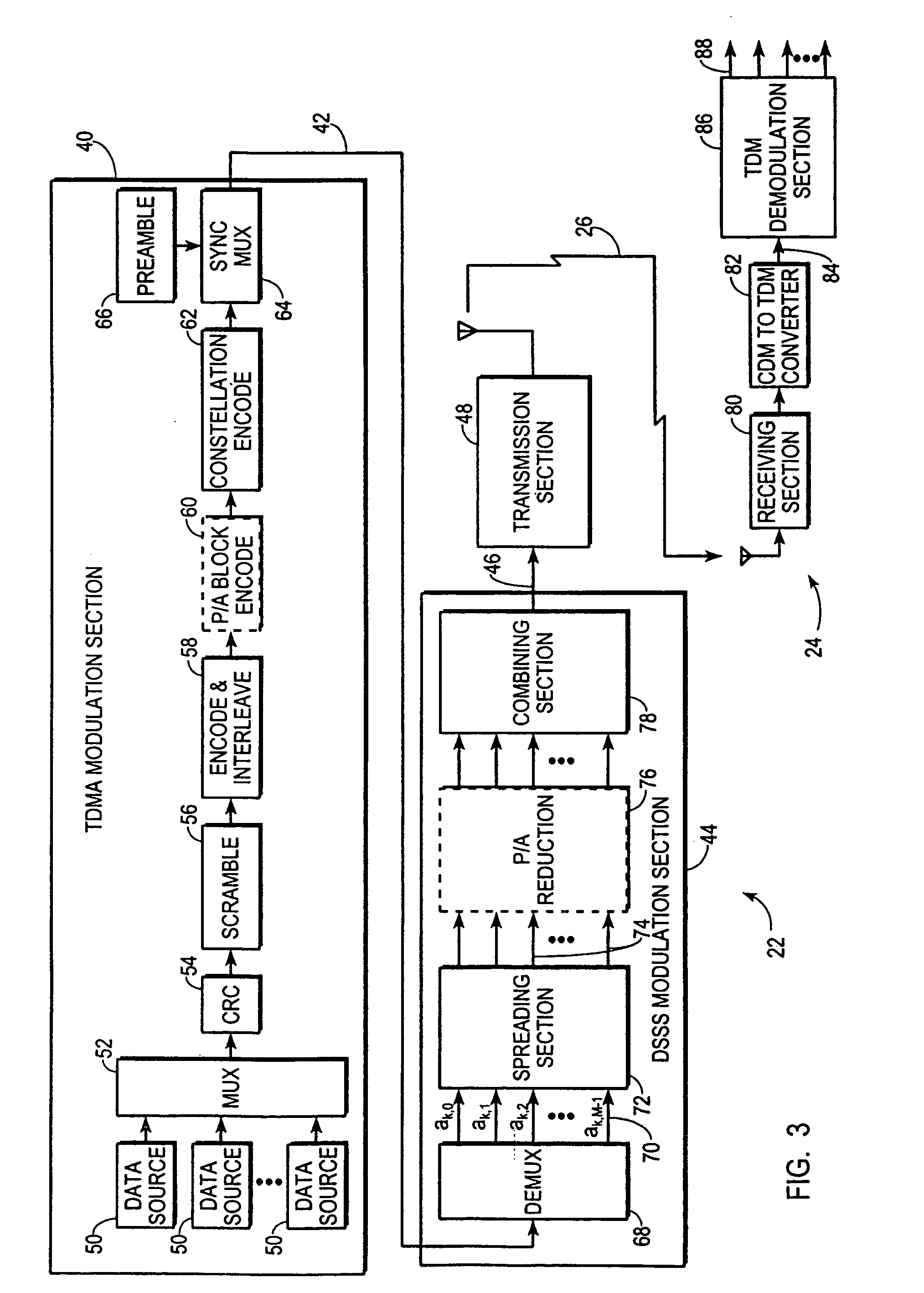CDMA/TDMA communication method and apparatus for wireless communication using cyclic spreading codes
a wireless communication and cyclic spreading technology, applied in the field of wireless communication, can solve the problems of ineffective use of spectrum, hard limit, and inability to achieve significant improvement in the results of dsss-cdma, and achieve the effects of improving the method and apparatus for wireless communication, improving wireless communication capacity, and simple processing techniques
- Summary
- Abstract
- Description
- Claims
- Application Information
AI Technical Summary
Benefits of technology
Problems solved by technology
Method used
Image
Examples
first embodiment
[0049]FIG. 5 shows a block diagram of DSSS modulation section 44. Demultiplexer 68 is omitted from FIG. 5 for convenience. The unspread substream 70 conveying symbols ak,0 experiences no delay before being fed to a first input of a multiplier 90. However, the unspread substreams 70 conveying symbols ak,1 through ak,M-1 are respectively delayed in delay elements 92 by 1 through M−1 symbol periods (T) before being fed to respective first inputs of other multipliers 90.
[0050]A spreading code generation section 94 generates cyclic variations of common spreading code 38. FIG. 5 illustrates code generation section 94 in matrix form, which matrix takes on a cyclic Toeplitz form because the matrix elements hold cyclic variations of the same spreading code 38. As depicted in FIG. 5, different columns of the matrix supply code chips C0 through CN-1 to second inputs of respective multipliers 90. Different rows of the matrix indicate different code chips to apply during different chip intervals...
third embodiment
[0054]Spreading code generation section 94 simply provides common spreading code 38, and need not be cycled because unspread substreams 70 to which spreading code 38 is applied are configured to perform the temporal offsetting requirements. Accordingly, symbol delay elements 92 are omitted and spreading code generating section 94 need not cycle the common spreading code or explicitly provide separate versions of spreading code 38 to separate unspread substreams 70. Nevertheless, in this third embodiment of DSSS modulation section 44, spreading section 72 temporally offsets application of common spreading code 38 by sequentially delaying symbols 36 to form unspread substreams 70 and applying spreading code 38 to the delayed symbols in unspread substreams 70 so that the resulting spread substreams 74 correspond to unspread substreams 70 modulated by cyclic variations of common spreading code 38.
[0055]FIG. 8 shows a first embodiment of CDM to TDM converter 82 included in receiver 24 (F...
PUM
 Login to View More
Login to View More Abstract
Description
Claims
Application Information
 Login to View More
Login to View More - R&D
- Intellectual Property
- Life Sciences
- Materials
- Tech Scout
- Unparalleled Data Quality
- Higher Quality Content
- 60% Fewer Hallucinations
Browse by: Latest US Patents, China's latest patents, Technical Efficacy Thesaurus, Application Domain, Technology Topic, Popular Technical Reports.
© 2025 PatSnap. All rights reserved.Legal|Privacy policy|Modern Slavery Act Transparency Statement|Sitemap|About US| Contact US: help@patsnap.com



